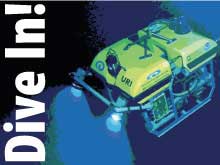
These lesson plans focus on the cutting-edge ocean exploration and research using state-of-the-art technologies and include topics such as light, color, and camouflage in the deep ocean; polarization vision; and vision in crustaceans.
Education Lesson Plans
The National Oceanic and Atmospheric Administration (NOAA) has a great opportunity to reach out in new ways to teachers, students, and the general public through its ocean exploration efforts and share the excitement of daily at-sea discoveries and the science behind its major ocean exploration initiatives with people around the world. Last summer, during Operation Deep Scope 2004 explorers looked into the deep ocean with ‘new technological eyes’ and revealed new organisms, behaviors, visual adaptations, and fluorescent compounds. Notable results from this mission included the discovery of a fluorescent shark, the fluorescence of methane hydrates, the first in situ footage of a large, undescribed species of deep-sea squid, the discovery of a bioluminescent anemone, the discovery that animals that appear to be transparent in the open ocean are clearly visible under polarized light, and the discovery that organisms collected under bright submersible lights are irreparably blinded. On Operation Deep Scope 2005, explorers will extend the envelope of this exciting frontier in ocean exploration with even more methods of seeing and collecting. Target field sites include deep Lophilia lithoherms on the southwest Florida shelf, Viosca Knoll, and the unexplored pinnacles on the west margin of DeSoto Canyon in the northern Gulf of Mexico.
The Operation Deep Scope 2005 Expedition presents a unique opportunity to engage explorers of all ages as we journey to a world that few have seen. Using the Harbor Branch Oceanographic Institution’s research vessel Seward Johnson and the submersible Johnson-Sea-Link, scientists will continue observations of the deep ocean using a modified version of the Eye-in-the-Sea camera, investigate the ecological roles of fluorescence in marine organisms, quantify light in deep-sea environments as it is perceived by its inhabitants, examine the role of polarized light reception, and investigate the sensitivity of eyes of deep-sea organisms to light.
Educators and scientists working with NOAA during August 2005 developed a series of inquiry- and National Science Education Standards-based lesson plans for students in Grades 5 –12 that are specifically tied to the Operation Deep Scope 2005 Expedition. These lesson plans focus on cutting-edge ocean exploration and research using state-of-the-art technologies and include topics such as light, color, and camouflage in the deep ocean; polarization vision; and vision in crustaceans.The lesson plans are grouped into the following categories: The lesson plans are grouped into the following categories:
Grades 5-6
Grades 7-8
Grades 9-12 (Chemical, Biological, Earth, and Physical
Science)
Each grade-level grouping includes an activity that focuses on the exploration and research being conducted as part of the Operation Deep Scope 2005 Expedition. In addition to being tied to the National Science Education Standards, the hands-on, inquiry-based activities include focus questions, background information for teachers, links to interesting Internet sites, and extensions. Web logs that document the latest discoveries and complement the lesson plans, complete with compelling images and video, will be sent back each day from sea. Teachers are encouraged to use the daily logs from the Operation Deep Scope 2005 Expedition, which are posted on this site, to supplement the lesson plans.
Read a description of each lesson plan and/or download them
to your computer. All of the lesson plans are available in pdf format,
and may be viewed and printed with the free Adobe Acrobat Reader ![]() . To download a lesson plan, click on its title from
the listing below.
. To download a lesson plan, click on its title from
the listing below.
Now You See Me, Now You Don’t (5 pages, 281Kb)
Focus (Life Science) Light, color, and camouflage in the deep ocean.
In this activity, students will be able to explain light in terms of electromagnetic waves, and explain the relationship between color and wavelength; compare and contrast color related to wavelength with color perceived by biological vision systems; and explain how color and light may be important to deep-sea organisms, even under conditions of near-total darkness. Students will also be able to predict the perceived color of objects when illuminated by light of certain wavelengths.
Twisted Vision (7 pages, 303Kb)
Focus (Life Science/Physical Science) Polarization vision.
In this activity, students will be able to explain the meaning of ‘polarized light,’ and will be able to identify three ways in which unpolarized light can become polarized; explain why some animals have polarization vision, and why humans do not have this ability; and discuss three ways in which polarization vision may be useful to marine organisms.
The Eyes Have It! (6 pages, 287Kb)
Focus (Life Science) Vision in crustaceans.
In this activity, students will be able to describe the overall structure of the crustacean compound eye; describe the eyes of stomatopods, and list three of their visual capabilities; and explain why most vertebrates are unable to detect polarized light, while this ability is more common among some invertebrate groups. Students will also be able to discuss three ways in which animals may benefit from polarization vision.
For More Information
Contact Paula Keener-Chavis,
Director, Education Programs
NOAA Office of Ocean Exploration
Other lesson plans developed for this Web site are available in the Education Section.


























